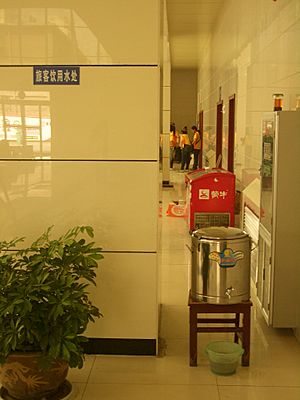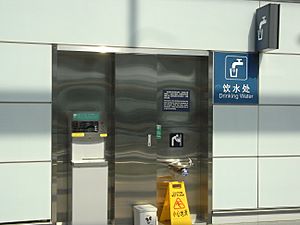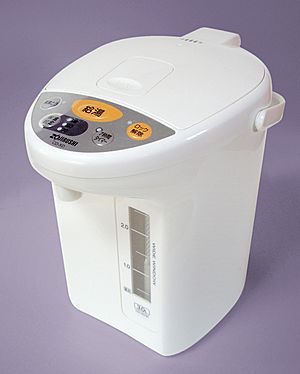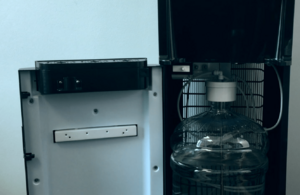Instant hot water dispenser facts for kids
An instant hot water dispenser or boiling water tap is a handy device that gives you hot water almost instantly. It heats water to about 94°C (201°F), which is very close to boiling. Some models only provide hot water, while others can give you both hot and cool water. Many also filter the water, making it cleaner to drink. These dispensers became popular in the 1970s because they make it easy to get hot water for drinks or instant meals without waiting for a kettle to boil.
Contents
How Do Instant Hot Water Dispensers Work?
Most instant hot water dispensers have a small tank inside that is well-insulated. This tank holds water and has a heater that keeps the water hot all the time.
When you press the handle or button, cool tap water flows into this tank. As the cool water enters, it pushes the already hot, near-boiling water out through the spout. When you let go of the handle, the flow stops. The cool water that just entered the tank then gets heated up to about 94°C (201°F), ready for the next time you need hot water. Some special models can even heat water to 110°C (230°F), so it comes out at 100°C (212°F).
Many dispensers have a heater that uses about 750 watts of power. They can provide a lot of hot water, sometimes up to 14 liters (about 60 U.S. cups) per hour. You can often adjust the water temperature with a dial.
Some dispensers also come with a special filtration system. This system helps remove bad tastes, smells, and tiny bits of dirt from the water. It can also get rid of harmful chemicals or heavy metals like lead. Even tiny living things like parasites are removed, though the hot water itself would usually kill them anyway.
Different Kinds of Hot Water Dispensers
There are several types of instant hot water dispensers, each with its own features.
Boil-on-Demand Dispensers
These are usually small and easy to move around. They have a heater that can boil a small amount of water very quickly, but they don't have a separate tank to store hot water. This means they use less electricity when not in use. However, they are not ideal if you need large amounts of hot water at once, and you often have to refill them.
Hot Water Tank Dispensers
These dispensers are connected directly to your home's water pipes. They have a tank that is usually placed under your sink or fixed to a wall above the counter. Hot water comes out through a special faucet at your sink.
These types can provide a lot of hot water and often let you adjust the temperature. They are very convenient because you don't need to refill them. However, they can be more expensive and require a plumber to install. They also use some electricity all the time to keep the water hot in the tank.
Thermo Pot Electric Kettle Dispensers
These are like a mix between an electric kettle and a thermos. You heat water in the pot, and then it stays warm inside the insulated pot. You can get the water out using a built-in electric pump or a manual push-down pump.
They are easy to use because you don't need to install them, and you can move them around. Many also let you set the water temperature. The downside is that you need to refill them (they usually hold 2 to 5 liters), and they use some electricity to keep the water hot constantly.
Bottom Load Water Dispensers
This type of dispenser is very convenient because the large water bottle is placed at the bottom of the unit. This means you don't have to lift a heavy bottle up high and flip it upside down to load it.
Table Top Water Dispensers
These are smaller units that you can place directly on a table or counter. They are often called countertop water dispensers and can provide both hot and cold water.
Direct Piping Water Dispensers
These dispensers connect directly to your home's water supply. They automatically refill themselves and provide a constant supply of hot or cold filtered drinking water without needing bottles.
Energy Use
A hot water dispenser that keeps water hot in a tank uses energy to heat the water and then more energy to keep it warm all the time, even when you're not using it. These tank-style dispensers often have "keep warm" and "reboil" features that can use extra energy.
On the other hand, an instant hot water dispenser without a tank doesn't waste much energy. It only heats water when you need it. When you turn it on, it quickly heats water, using about 2000 watts. This type of dispenser can produce hot water much faster than a tank model. Since it doesn't "keep warm" or "reboil," it can save energy. You also don't need to switch it off when you're not using it.
Sometimes, you might need hot water instantly for cooking, like when making risotto. In these cases, an instant water heater that only heats what you need can be more efficient than boiling a large amount of water in a kettle just in case.
To save energy, it's a good idea to switch off tank-style dispensers when you don't need them, like overnight.
Installation
Instant hot water tank dispensers can be installed by homeowners or by a professional plumber. They usually fit into a standard sink hole, with the tank placed underneath the sink.






